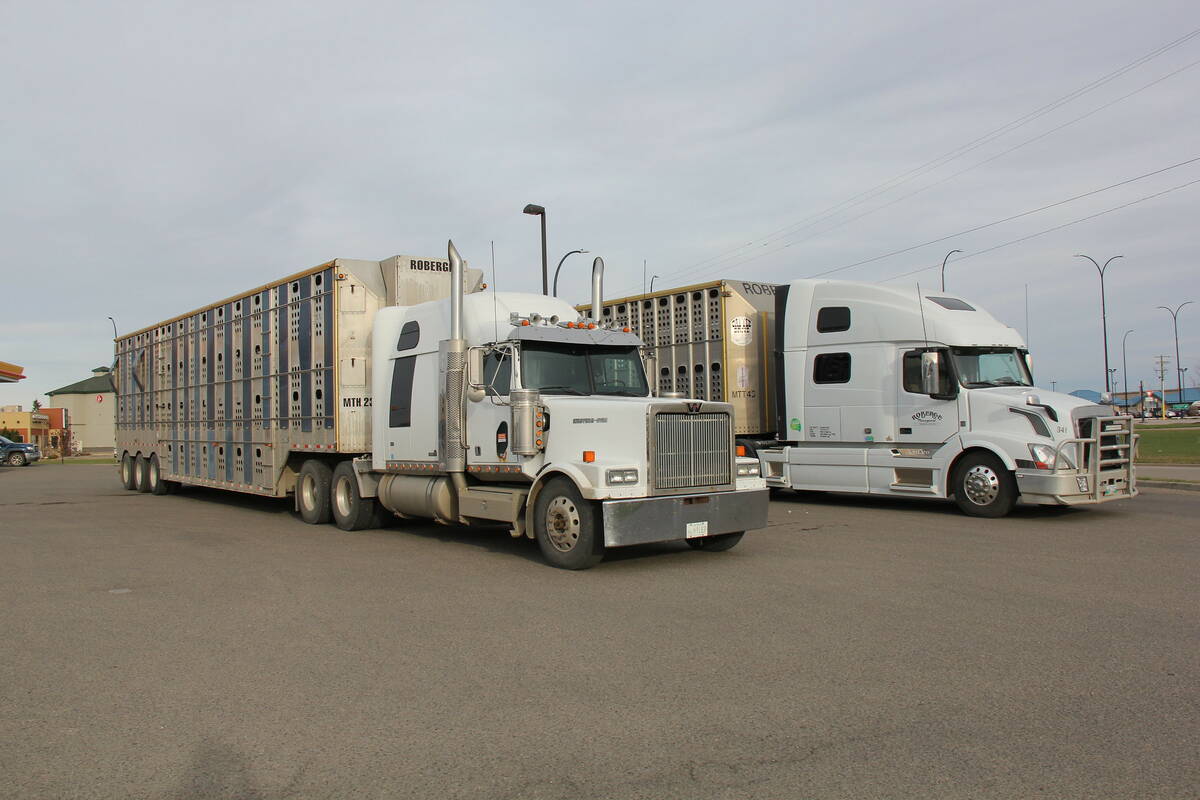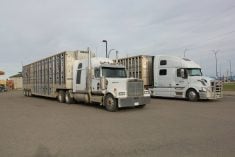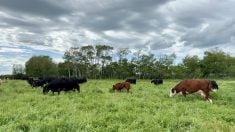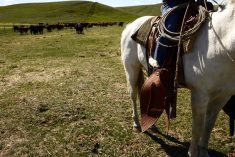Estrogenic and androgenic growth implants improve average daily gain and feed efficiency, which translates to more money in your pocket. A conservative return on investment would be 10:1 ($10 for every $1 spent on implants). Most trials have shown a 20:1 return. Nutrition and age of animal will have a large impact on the added gains. Clinical trials on implanted suckling calves show an average of 15-25 pound advantage at weaning for implanted calves. It’s like getting a free calf for every 20-33 calves implanted.
There are also negative effects — increased bullers and decreased marbling (grade). Therefore, when considering a growth implant you must first consider the end point for the animal, and then weigh the advantages and disadvantages.
Read Also

Research shows rest stops of no benefit to feeder calves during long hauls
Three Canadian transport trials showed that providing a rest stop during long-distance transport provided no clear or consistent benefits for the health or welfare of feeder calves.
NOTE: Implants work independently from previous implants. A previously implanted animal benefits the same as an animal that has never been implanted before. This is why serial implantation is part of most feedlot protocols.
Estrogenic implants
These implants contain estradiol benzoate, estradiol 17B or zeranol that stimulate the pituitary gland to increase muscle and skeletal growth rates. To accomplish these gains, the animal must eat more and an increase in appetite can be noted as early as four hours after implanting. Increased appetite means more energy and therefore healthier immune systems. This is why studies show calves implanted on arrival at a feedlot suffer less morbidity then non-implanted animals.
All calf implants are safe for potential replacement heifers (over 30-45 days of age, depending on the brand), with minimal or no effect on fertility later in life. Even so, implanting known replacements is not recommended, primarily because there is no economic advantage to increasing the weaning weight of a heifer that has lots of time to gain that weight before her first calf. So there is no need to take any risk of affecting future fertility with known replacements. The decision to implant or not is a little more difficult if you don’t pick replacements until weaning. It depends partly on how many you are keeping. If you only keep 10 per cent of your heifer calves, implanting them all at 45 days will be economical.
The negative effects with these implants include increased bullers and decreased marbling. Bullers are more significant in incorrectly implanted animals due to crushed pellets or infections at the injection site. A bit of practice can nearly eliminate these problems. Some implants are impregnated with antibiotics to prevent infections that can affect absorption of the estrogen.
Estrogen is the hormone that causes estrus behavior in females, so when you add estrogen implants (and more so if the implants are crushed causing accelerated absorption), you are likely to see an increase in riding and other estrus behaviours, especially in heifers. Bulling is not generally a problem in suckling calves.
Estrogenic implants have much less effect on grade then androgenic implants.
Androgenic implants
Trembelone acetate (TBA) has a testosterone-like effect, increasing muscle mass and reducing the degradation rate of that muscle. This results in increased feed efficiency. These are generally terminal implants (given approximately 100 days prior to slaughter). TBA combines with estrogen to increase the performance of these combination implants. The cattle eat more because of the estrogen and use feed more efficiently because of androgen.
Bullers are more of a problem with androgenic implants because the TBA mimics testosterone. They are also much more prone to injection site infections, which can contribute to bullers. However, studies have shown that with the addition of antibiotics to these implants, which prevent infections and therefore result in a more constant release of the hormones, the incidence of bullers can be decreased by 50 per cent. Again, care to prevent crushing of the implant pellets during administration is a very important preventative measure in the incidence of bullers. The effect of these implants on heifers in terms of bullers is much less then with steers.
A more important negative effect of the androgenic implant is the effect on marbling when selling animals on the rail. Therefore, the beef is going to be graded lower. The androgenic implant causes increased muscling at the expense of fat deposition. The negative effect on fat is permanent once the androgenic implant is given. You cannot just wait for the implant to wear off. The fat tissue has been permanently impeded.
Many backgrounder lots want to simply let the animals mature, keeping them lean so that when sold or put on grass, they will quickly gain weight. Obviously an estrogenic implant does not fit this situation as it causes increased appetite and fat deposition. There is a low-dose TBA implant available that increases muscle and frame growth, improves feed efficiency, and has very little negative effects on grade. This implant allows these animals to be fed economically and produces a framey, lean animal that is set to quickly put on weight.
“The more aggressive the implanting program, the higher the risk of reduced quality grade and increased dark cutters,” according to the Component implants technical reference guide. The higher the concentration of TBA in an implant, the more aggressive it is. Therefore, when marketing beef on the rail, be aware of the effects of these implants.
Dr. Glen Griffin is a veterinary practitioner from Southwest Animal Health Center in Swift Current, Sask., and a member of the Western Canadian Association of Bovine Practitioners who co-ordinate this column
To suggest a future topic for the Vet Advice column contact CATTLEMEN, THE BEEF MAGAZINE, 1666 Dublin Ave., Winnipeg, Man. R3H 0H1, or[email protected]















